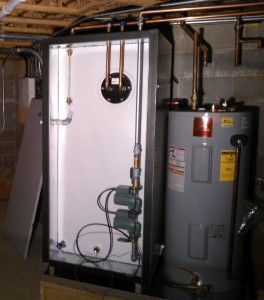December’s Solar Thermal Webinar
Happy Holidays to our readers! If you were unable to tune in to our most recent solar thermal webinar, we’ve posted a recording here. What did we cover? A lot! But primarily we discussed a tool called the Engineering Data Form. This a spreadsheet that we use to help properly size the major components of a solar fluid handling system: tank volume, pump power, heat exchanger capacity, controls, and options. We hope you find it useful in your solar water heating projects. If you’d like a copy of it, let us know!
See you all next year!
Dr. Ben


Great solar thermal blog! Check out solar hot water in Nova Scotia @ http://www.doctorsolar.ca
Thank you for the informative articles. have you encountered questions RE preventing ‘growth’ (bacteria, mold etc) in the unpressurized drain back tanks? Is there an ‘accepted’ additive to prevent this?
Bruce,
You have asked a very important question that relates to the safety of non-pressurized solar systems. Unfortunately, you are going to get a long winded answer, so grab a cup of coffee and relax.
Actually, the safety question applies to all solar systems, not just drainback. And it applies to any fluid used in a solar system – on the collector side or the tank side.
For years, the assumption has been that Propylene Glycol (PG) used in a pressurized system was non toxic because it is used in food. This is a “zero day” assumption, but what happens one or two or five years later? Current solar Propylene Glycol solutions also have corrosion inhibitors included. There are no safety standards I know of that look at solar heat transfer fluid aging.
Now, back to your question about bacteria growth inside a non pressurized drainback solar tank. The corrosion inhibitor in our tanks raises the PH level to 10.5, which is very basic. I am not a biologist or a toxicology expert, but I try to keep up with the subject as best I can. So I looked up the survival of bacteria in different pH levels and found the following table from Nutrition and Growth of Bacteria <http://textbookofbacteriology.net/nutgro_4.html>. [Sorry about the formatting, no good way to show a table]
Table 8. Minimum, maximum and optimum pH for growth of certain procaryotes.
Organism_____________________Minimum pH______Optimum pH_______Maximum pH
Thiobacillus thiooxidans________0.5__________2.0-2.8__________4.0-6.0
Sulfolobus acidocaldarius_______1.0__________2.0-3.0__________5.0
Bacillus acidocaldarius_________2.0__________4.0______________6.0
Zymomonas lindneri______________3.5__________5.5-6.0__________7.5
Lactobacillus acidophilus_______4.0-4.6______5.8-6.6__________6.8
Staphylococcus aureus___________4.2__________7.0-7.5__________9.3
Escherichia coli________________4.4__________6.0-7.0__________9.0
Clostridium sporogenes__________5.0-5.8______6.0-7.6__________8.5-9.0
Erwinia caratovora______________5.6__________7.1______________9.3
Pseudomonas aeruginosa__________5.6__________6.6-7.0__________8.0
Thiobacillus novellus___________5.7__________7.0______________9.0
Streptococcus pneumoniae________6.5__________7.8______________8.3
Nitrobacter sp__________________6.6__________7.6-8.6__________10.0
The Nitrobacter bacteria seem like the only ones who have a chance of survival in a fresh charge of the corrosion inhibitor (“zero day” results).
What is this Nirtorbacter bacteria anyway? From the Canadians, we find the document
Draft Screening Assessment report of Nitrobacter winogradsky ATCC 25391, Nitrobacter species 18132-6, Nitrobacter species 16969-4, Nitrosomonas europaea ATCC 25973, Nitrosomonas species 16968-3, Nitrosomonas species 18133-7, Rhodopseudomonas palustris ATCC 17001, Rhodopseudomonas species 18136-1.
The article is about
….the Ministers of the Environment and of Health have conducted a screening assessment of eight lower-hazard (Priority C) micro-organism strains. These strains … were manufactured in or imported into Canada between January 1, 1984 and December 31, 1986, and they entered or were released into the environment without being subject to CEPA 1999 or any other federal or provincial legislation.
Table 1. List of micro-organisms in the Priority C Lot 1
Organism____________________Strain/Accession Number
Nitrobacter winogradskyi_________ATCC 25391
Nitrobacter species______________18132-6
Nitrobacter species______________16969-4
Nitrosomonas europaea____________ATCC 25978
Nitrosomonas species_____________16968-3
Nitrosomonas species_____________18133-7
Rhodopseudomonas palustris_______ATCC 17001
Rhodopseudomonas species_________18136-1
The bottom line was
Hazard assessment
The eight micro-organisms in Lot 1 are naturally occurring bacteria. None is recognized as a human pathogen by the Public Health Agency of Canada and no adverse human health effects have been associated with these strains, their genetic material, secondary metabolites or structural components. Similarly, none of these strains are recognized as animal or plant pathogens by the Canadian Food Inspection Agency or by any member country of the International Plant Protection Convention. Furthermore, an in-depth scientific literature search yielded no reports of the presence of virulence factors or evidence of toxicity or pathogenicity towards humans, plants, vertebrates, or invertebrates. These observations are supported by genomic sequencing and analysis of these strains (Starkenburg et al., 2006; Chain et al., 2003; Larimer et al., 2004). In the unlikely event of infection, all Lot 1 strains are susceptible to clinically relevant antibiotics.
The hazard potential associated with the micro-organisms in Lot 1 was estimated to be low for both the environment and human health.
Finally, there is one other parameter that affects the survival of bacteria in a solar tank. That is temperature. Another article on Nitrobacter bacteria states
“Nitrobacter have an optimum pH between 7.3 and 7.5, and will die in temperatures exceeding 120°F (49°C) or below 32°F (0°C).[1]”
The purpose of a solar system is to get hot. We normally set our high limit at 160F, which can be a frequent occurance during the summer, or when the load is low (holidays, weekends, seasonal load variation, etc). Certainly temperatures of 120F and above are a frequent occurrence.
Since 1978 I have never heard of any human hazard from one of our solar systems other than minor burns from a hot pipe.
If you are still awake, I hope this sheds some light on your question.